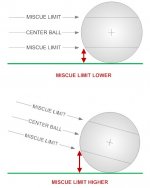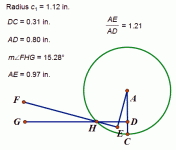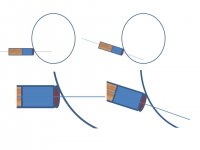You are using an out of date browser. It may not display this or other websites correctly.
You should upgrade or use an alternative browser.
You should upgrade or use an alternative browser.
A proof without words: Why elevating a cue slightly may increase draw:
- Thread starter Bob Callahan
- Start date
same principle
I didn't read the equations, the picture seems to make the point clearly enough. The table limits how low we can hit the cue ball. By angling the stick we can hit very slightly lower, however the major value is that we can change the direction of force.
Hu
I didn't read the equations, the picture seems to make the point clearly enough. The table limits how low we can hit the cue ball. By angling the stick we can hit very slightly lower, however the major value is that we can change the direction of force.
Hu
You also have to take into consideration that your not hitting a single point on the ball. Your hitting with a wide point (tip). With a level cue more of your tip is hitting the Cue which in my mind means more friction, therefore, more Cue reaction.
When you elevate, you lower the amount of tip that is contacting the cue. increasing your chance for a miscue. ALSO, if you have to apply any left or right english, you have now turned the shot into a masse.
Just thought, these are all opinions. be gentle.
When you elevate, you lower the amount of tip that is contacting the cue. increasing your chance for a miscue. ALSO, if you have to apply any left or right english, you have now turned the shot into a masse.
Just thought, these are all opinions. be gentle.
Not quite true, IMHO
With a smaller diameter shaft you can reach the maximum distance from the center before miscue. A larger shaft will hit the table and cause a miscue. Problem with elevating the shaft is some of the energy is forced down into the table and doesn't result in increased rotation but in the CB leaving the table. Also the resistance of the table on the CB, your shooting down into the table even with a little angle, creates a stronger likelyhood of miscue.
I think thats why for maximum draw, most experts recommend a level cue. Its certainly better for accuracy. I would agree that a smaller diameter shaft allows you to get a little lower than a fat shaft, which increases spin/draw.
With a smaller diameter shaft you can reach the maximum distance from the center before miscue. A larger shaft will hit the table and cause a miscue. Problem with elevating the shaft is some of the energy is forced down into the table and doesn't result in increased rotation but in the CB leaving the table. Also the resistance of the table on the CB, your shooting down into the table even with a little angle, creates a stronger likelyhood of miscue.
I think thats why for maximum draw, most experts recommend a level cue. Its certainly better for accuracy. I would agree that a smaller diameter shaft allows you to get a little lower than a fat shaft, which increases spin/draw.
Last edited:
I always thought that the reason a jacked up stroke imparts more draw is simply because a flat stroke imparts more forward motion. With a jacked up stroke, the forward direction is partially into the table and thus has less forward speed with the same (if not more) spin. This lower speed makes it easier for the cueball to reverse off the object ball. Thats not to say a jacked up stroke is better in all instances especially when you consider swerve. If you don't make the ball, it doesn't matter how much draw you get.
I think the point you are trying to make should be very obvious if looked at differently. I mean, take that angle to the extreme and see what happens. At > 45 degrees, the cue ball might not even reach the object ball (ie. masse). This results from the forward component of force not being able to compete with the "reverse" or draw component of force vector.
Would love to hear what a physics/math professor would say about this. Dr. Dave? lol
Here you go:
Dr. Dave on draw shot physics - elevation effects
There's a flaw in your presentation. You have both angles(the jacked and the level cue) hitting the same spot on the cueball, so naturally the jacked cue is hitting "lower" on the ball. If you lower the level cue, however, to duplicate the same slice on the cueball the effect of the draw would be the same.
Basically, your diagram shows that you are not hitting the cueball the same. Someone with more knowledge may correct me, but I also think hitting down on the cueball results in more unwanted jumps, and that all important "follow through" has been eliminated by jacking. If you try to follow through on a jacked cue you end up scooping.
Last edited:
You also have to take into consideration that your not hitting a single point on the ball. Your hitting with a wide point (tip). With a level cue more of your tip is hitting the Cue which in my mind means more friction, therefore, more Cue reaction.
When you elevate, you lower the amount of tip that is contacting the cue. increasing your chance for a miscue. ALSO, if you have to apply any left or right english, you have now turned the shot into a masse.
Just thought, these are all opinions. be gentle.
I do believe that the same amount of tip surface strikes the cue ball from any angle cue stick....SPF=randyg
Cue Contact
I am no professional by any means. However, I can see where without taking into account tip compression. If you elevate the cue, and hit the same point with a level cue, You would be hitting with less surface area of the tip. I did my best to illustrate my thoughts. I have limited means.
However, Dr. Dave says the following on his site. "...The more you elevate the cue, the less spin the CB will have when it gets to the OB, for a given tip offset and cue speed." Preceeded by justification. Being that the cue will lose more spin due to the bouncing effect gained by elevating the cue.
C
I am no professional by any means. However, I can see where without taking into account tip compression. If you elevate the cue, and hit the same point with a level cue, You would be hitting with less surface area of the tip. I did my best to illustrate my thoughts. I have limited means.
However, Dr. Dave says the following on his site. "...The more you elevate the cue, the less spin the CB will have when it gets to the OB, for a given tip offset and cue speed." Preceeded by justification. Being that the cue will lose more spin due to the bouncing effect gained by elevating the cue.
C
Attachments
If the G stroke is at the miscue limit, then the F (elevated) stroke would be a miscue. So this is not a fair comparison.
Actually the maximum draw shots made by trick shot artists like Mike Massey are done with the cue elevated at a near ninety degree angle to the table. They shoot straight down on the cue ball, hitting the back half of the ball. It's a full force total masse shot (I don't know another name for it).
This is the shot where they make an object ball (placed near the cue ball) in the corner pocket and draw the cue ball along the rail all the way up table to make another object ball in the opposite corner pocket. The cue ball takes off at 100 mph and races up table to make the second ball. Mosconi and Fats used to shoot this shot in their exhibitions too. I'm sure others have used it as well.
Of course Massey also shoots a shot where he places the cue ball about an inch from the object ball and draws it three rails around the table to make another ball. This is done with a more conventional (level) stroke.
My own personal opinion after hitting about a million draw shots, that if I am shooting straight at an object ball, I will get maximum effect by keeping my cue level and hitting low on the cue ball and following through. But what do I know. I'm not a physicist, I just play the game. :wink:
This is the shot where they make an object ball (placed near the cue ball) in the corner pocket and draw the cue ball along the rail all the way up table to make another object ball in the opposite corner pocket. The cue ball takes off at 100 mph and races up table to make the second ball. Mosconi and Fats used to shoot this shot in their exhibitions too. I'm sure others have used it as well.
Of course Massey also shoots a shot where he places the cue ball about an inch from the object ball and draws it three rails around the table to make another ball. This is done with a more conventional (level) stroke.
My own personal opinion after hitting about a million draw shots, that if I am shooting straight at an object ball, I will get maximum effect by keeping my cue level and hitting low on the cue ball and following through. But what do I know. I'm not a physicist, I just play the game. :wink:
A level cue will get you further through the ball and more reaction. Additionally, what are you trying to achieve? You still need accuracy to play the game and elevating the cue will reduce this aspect.
The Massey extreme draw shot:
http://www.youtube.com/watch?v=oI1Q-8nfiBk
Check out the angle of the cue at impact.
http://www.youtube.com/watch?v=oI1Q-8nfiBk
Check out the angle of the cue at impact.
A level cue will get you further through the ball and more reaction.
How is this true????
Thanks....SPF=randyg
When you elevate your cue you also "elevate" the miscue limit on the CB:

This means you can't hit as close to the cloth with an elevated cue as with a level cue. All else being equal, you get the same amount of backspin (because you're still hitting the same distance from "center ball") - but all else isn't equal.
Hitting the CB down into the cloth creates more ball/cloth friction at the instant of the hit (and on each hop), but also makes the CB hop, which reduces sliding friction during CB travel - these effects work against each other and may cancel each other.
However, the greatest effect from hitting down on the CB is that you create more rotational speed with less forward speed - a greater "spin-to-speed ratio". This is what we usually mean when we say "more backspin".
Greater spin/speed ratio allows the CB to draw farther while moving the OB a smaller distance (useful for some safeties, especially in 1-pocket), or it allows the CB to draw at a steeper angle on cut shots (useful for position in all games). But it doesn't create more draw distance than is possible with a level cue.
pj
chgo
P.S. As others have said, the other main effect of elevating the cue is loss of accuracy, both because sighting is harder and because any CB swerve (intended or not) is increased.

This means you can't hit as close to the cloth with an elevated cue as with a level cue. All else being equal, you get the same amount of backspin (because you're still hitting the same distance from "center ball") - but all else isn't equal.
Hitting the CB down into the cloth creates more ball/cloth friction at the instant of the hit (and on each hop), but also makes the CB hop, which reduces sliding friction during CB travel - these effects work against each other and may cancel each other.
However, the greatest effect from hitting down on the CB is that you create more rotational speed with less forward speed - a greater "spin-to-speed ratio". This is what we usually mean when we say "more backspin".
Greater spin/speed ratio allows the CB to draw farther while moving the OB a smaller distance (useful for some safeties, especially in 1-pocket), or it allows the CB to draw at a steeper angle on cut shots (useful for position in all games). But it doesn't create more draw distance than is possible with a level cue.
pj
chgo
P.S. As others have said, the other main effect of elevating the cue is loss of accuracy, both because sighting is harder and because any CB swerve (intended or not) is increased.
Last edited:
RBC
Deceased
If the G stroke is at the miscue limit, then the F (elevated) stroke would be a miscue. So this is not a fair comparison.
As always, I agree totally with your observation!
To me, both tip positions look like a miscue. I have always believed that you have to have at least half of the mass of the cue ball in front of your tip to prevent a miscue. That may be wrong, but to me once you are outside the center one half of the cue ball mass you pretty much have to miscue. You can't hit less than one quarter of the mass and propel the whole mass in the direction you are hitting.
Does that sound right to you Mike? Help me if I'm not quite straight!
By the way, everyone should visit Fargo Billiards! Mike's place is fantastic!
Royce Bunnell
www.obcues.com
The Massey extreme draw shot:
http://www.youtube.com/watch?v=oI1Q-8nfiBk
Check out the angle of the cue at impact.
Thanks Bob. Notice Mike said he hits the cue ball VERY LOW and LEVEL and FOLLOWS THROUGH!

